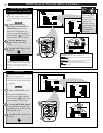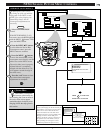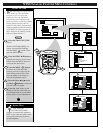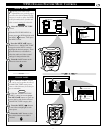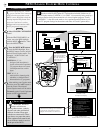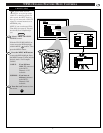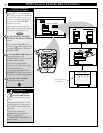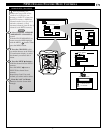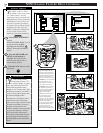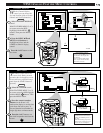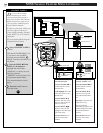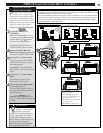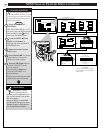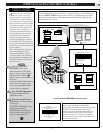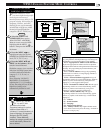
NTSC/ANALOG FEATURE MENU CONTROLS
NTSCNTSC
++
++
mute
volume
channel
ok
exit
menu
DTV
Analog
DTV4/4
1
2
3
1
2
FEATURE MENU
EXIT
2 OF 3
DISPLAY
FORMAT
MORE...
CHANNEL
LABELS
CHANNEL
DISPLAY
PARENTAL
CONTROL
EXIT
PANORAMIC
4 X 3
16 X 9
THEATER 1
THEATER 2
DISPLAY FORMAT
Building Trade News
Building Trade News
Building Trade News
Building Trade News
DISPLAY FORMAT
16
FEATURES
EXIT
MAIN MENU
SOUNDPICTURE
1ST TIME SETUP
Y
our DPTV is able to deliver
the lifelike, widescreen picture
(or “home cinema” viewing
experience) that is promised with
High Definition TV programming.
The Display Format control can
be used to expand conventional
4:3 aspect ratio (width-to-height)
broadcasts in order to fit your
DPTV’s widescreen 16:9 format;
or to reset the screen to best
match the current programming.
Select DISPLAY FORMAT
control.
With FEATURES MENU (2 of 3)
on-screen, move the RED
highlight with the MENU
buttons. Then press the MENU
button.
Press the MENU ▲▼ and
MENU (or ok) buttons
to
highlight and select (
ߜ) the
desired screen aspect ratio or
screen display control.
Press the “exit” button to clear
the screen.
1
2
3
STOP
BEGIN
Panoramic - Conventional picture
is expanded to fill the full 16:9
aspect ratio screen area. Most of
the non-linear picture expansion is
performed toward the outer edges
so that correct proportions are
retained in the center of the screen.
4:3 (Standard) - Conventional TV
picture format shows on the
screen. Black bar areas show on
the side margins of the screen.
16:9 (Expand) - Full widescreen
mode with linear expansion to
view HDTV program broadcasts.
Used for material originally
produced in 16:9 format.
Theater 1/2 - Expanded zoom
modes with picture images
increased in magnification.
Designed for use with “letterbox”
or cropped movie images such as
found with Cinemascope or
Cinerama type program material.
Note: With the Theater modes
there can be some loss of
information at the edges as the
picture expands to fill the screen.
Panoramic
4:3 (Standard)
16:9 (Expand)
Theater 1 or 2
SMART HELP
Note: In the past the
relationship between a TV
screen’s width to height, or aspect
ratio, has historically been 33%
wider than the picture screen
height (or a 4:3 aspect ratio). The
widescreen format of your DPTV
screen is nearly 80% greater than
its measure height (which
accounts for a 16:9 aspect ratio).
The reason for the 16:9 aspect
ratio screen is that it allows for the
dramatic and lifelike viewing of
original version movies and
cinemas (similar to the type found
in your local theaters). And the
16:9 aspect ratio widescreen is
also a good visual match for how
our eyes work in a horizontally
oriented field of view and action
plane.



